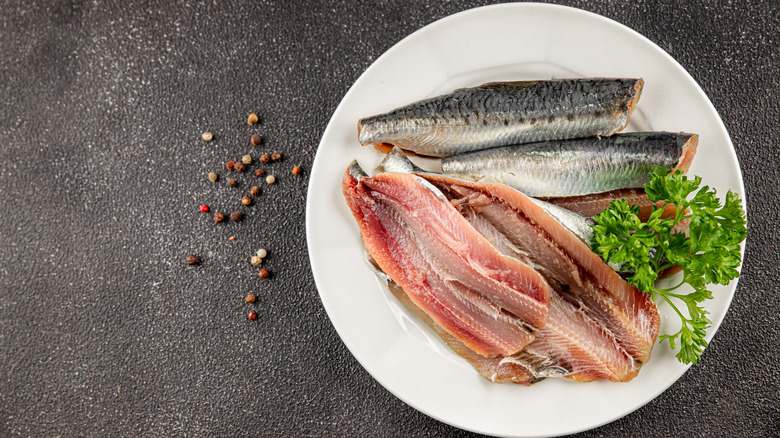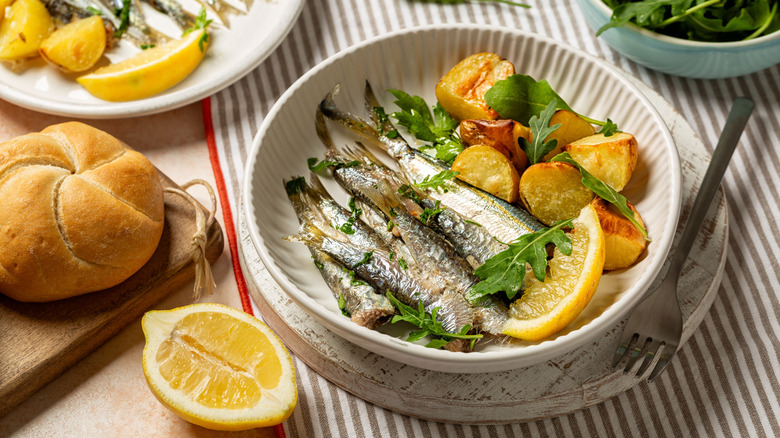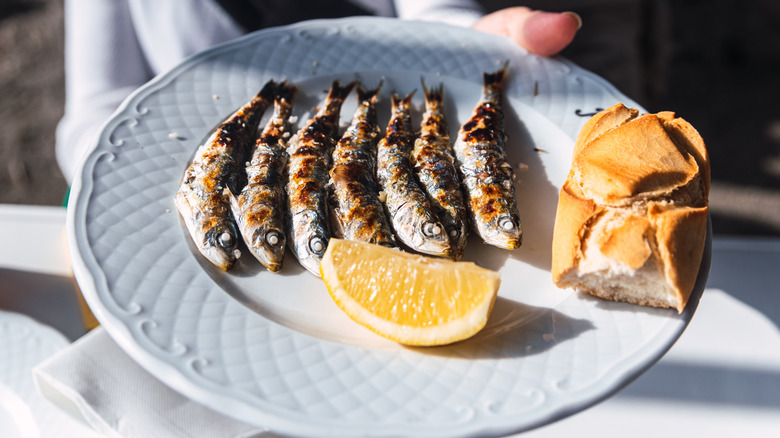How To Clean And Fillet Fresh Sardines Like A Pro
They may be small, but sardines are the oily powerhouses of the sea. Often mistaken for the similarly omega-3-rich anchovies, sardines bring their own briny charm to the table. You'll find them lining grocery shelves canned, smoked, or fresh, ready to add a savory touch to a pasta con sarde or to sizzle on the grill during Lisbon's annual Festas de Santo António. But before the fun begins, sardines need to be carefully cleaned and filleted — a less glamorous but essential step that ensures you won't encounter any stray bones. To find out how it's done, Food Republic consulted Charlotte Langley, chef and founder of Langley Foods and Nice Cans.
Before you start, make sure you've sourced a good-quality sardine. Signs of a healthy, fresh fish include shiny, silvery, and firm skin. "Fresh sardines are tender, so I always start by rinsing them gently under cold water and patting them dry," Langley told us. This is also a good time to remove the scales. With a light touch, use the back of a "small, sharp knife" to scrape them off from tail to head. To prevent spoilage and bitter flavors, Langley advises, "Make a shallow cut along the belly from head to tail and remove the innards. Then, pinch the head between your thumb and forefinger and pull it forward — the backbone will usually follow." After a quick rinse of the cavity to clear away any remaining gunk, you'll have a beautifully clean sardine fillet ready for the grill.
Minimize waste and preserve the sardines' flavor
Sardines can be one of the ocean's more sustainably sourced species thanks to their small size, rapid growth, and high reproductive rates. In this spirit, you should aim to minimize waste, which also happens to contribute to the flavor of your sardines. "Keep the fillet whole, skin on; that's where the flavor lives. Sardines are rich in natural oils," Charlotte Langley told us. "Minimal trimming means maximum taste."
For presentation purposes, you can trim off excess edges like the tail. It's also not uncommon for fillets to be divided in half. Another way to avoid losing flavor is to "never over-rinse — just a quick pass under cool water — because the oils are what give sardines that beautiful depth and richness when cooked or cured," Langley explained. These oils keep the flesh moist and flavorful, and are the reason you should generally opt for sardines canned in oil rather than water when buying pre-packed for optimal taste and texture.
To enhance the depth of flavor in your sardines, consider salt-curing the fillets or brining them in lightly salted water. This not only improves the taste but also helps to preserve them and reduces overly fishy notes. Another way to deepen their flavor and firm up their texture is by letting them sit in a marinade for a few hours. To brighten their natural richness and cut through the oiliness, consider adding an acidic touch like lemon or vinegar before cooking — they taste great on toast with tomato relish or as part of a bright citrus salad.
Pro tips for effortlessly cleaning and filleting sardines
Sardines are small and delicate, and filleting them properly requires a precise eye and a steady hand. Fortunately, there are several small tools and techniques that can make the process faster and more efficient. According to Charlotte Langley, "A good pair of fish tweezers, a paring knife, and a cold workspace make all the difference."
A quality pair of fish tweezers (which are distinct from regular kitchen tweezers) is essential for removing even the tiniest pin bones without tearing the flesh. This not only keeps the fillets intact but also prevents accidental swallowing of bones, which can be irritating at best and, in serious cases involving larger fish, a choking hazard. Meanwhile, a sharp paring knife is small and precise enough to allow gentle, controlled cuts along the fillet, significantly reducing the risk of injury compared to using a traditional kitchen knife. "If you're doing this often, a flexible filleting knife is worth the investment," Langley added. These knives are designed with a thin, extra-flexible blade that bends to easily glide along the backbone and between the skin and flesh of the sardines, making it easy to maneuver around the delicate bones.
"I'll sometimes keep a bowl of ice water nearby to rest the cleaned fillets," Langley told us. "It firms them up slightly for easier handling," providing an extra layer of protection against the skin breaking apart. It's also an important practice to keep the fish chilled to retain its freshness and prevent spoilage.



